4th-5th May Important Events By Kandela IAS
“RBI’s Shankar advocates widespread use of CBDCs for streamlined cross-border transactions” ( GS -3)

Sankar emphasized that CBDCs have the potential to make cross-border transactions more efficient, secure, and cost-effective. CBDCs can also reduce the reliance on intermediaries, thereby increasing the speed of transactions and reducing counterparty risks. Furthermore, CBDCs can enable instantaneous settlement and increase transparency in cross-border payments.
The Deputy Governor also acknowledged the challenges associated with the implementation of CBDCs, such as the need to ensure the security and resilience of the payment system. Sankar mentioned that the RBI is exploring the possibility of launching a digital version of the Indian Rupee, but noted that the central bank will undertake a thorough assessment before launching the CBDC.
Sankar also spoke about the potential benefits of a CBDC in addressing financial inclusion, as it can enable access to digital payment systems for individuals without bank accounts. He highlighted that the RBI is committed to promoting financial inclusion and is exploring the use of CBDCs in this context.
In conclusion, Sankar reiterated that the adoption of CBDCs can bring about significant benefits for cross-border payments, and that the RBI is closely monitoring developments in this space. The central bank is exploring the possibility of launching a CBDC, and will undertake a thorough assessment to ensure the security and resilience of the payment system before making any decisions.
Central Bank Digital Currency (CBDC)
Central Bank Digital Currency (CBDC) is a new form of digital currency that is issued and regulated by a country’s central bank. It is a new digital payment system that provides many benefits, including faster and cheaper transactions, improved financial inclusion, and greater security.
⦁ Definition of CBDC: CBDC is a digital version of a country’s fiat currency that is issued and backed by its central bank. Unlike other digital currencies, such as cryptocurrencies, CBDC is a legal tender and has the same value as physical currency.
⦁ Types of CBDC: There are two types of CBDC: retail CBDC and wholesale CBDC. Retail CBDC is intended for use by the general public, while wholesale CBDC is designed for use by financial institutions.
⦁ Benefits of CBDC: CBDC has several benefits, including faster and cheaper transactions, improved financial inclusion, greater security, and reduced risk of fraud.
⦁ Potential drawbacks of CBDC: CBDC also has some potential drawbacks, such as the risk of cyberattacks, increased government surveillance, and a potential shift away from traditional banking.
⦁ Current status of CBDC: Several central banks around the world, including the People’s Bank of China and the Bank of England, are currently exploring the development of CBDC. The Bahamas has already launched its own CBDC, called the Sand Dollar.
⦁ Challenges in implementing CBDC: Implementing CBDC faces several challenges, including technological limitations, regulatory hurdles, and the need for collaboration between central banks, financial institutions, and other stakeholders.
⦁ CBDC and the future of finance: CBDC has the potential to transform the financial industry by providing faster, cheaper, and more secure digital payments. However, its success depends on overcoming the challenges and addressing potential drawbacks.
CBDC is an emerging digital payment system that offers several benefits, including faster and cheaper transactions, improved financial inclusion, and greater security. While it faces some challenges, CBDC has the potential to transform the financial industry and improve the lives of people around the world.
“India and Russia halt negotiations on settling trade payments in rupees” (GS- 2)

⦁ India and Russia have reportedly suspended talks to settle trade in rupees, according to sources.
⦁ The move follows Russia’s decision to ban the import of certain goods from India, including tea, coffee, and basmati rice, citing concerns over pests.
⦁ India had proposed settling trade in rupees to counter the impact of US sanctions on Russia, which have made it difficult for the country to access dollars.
⦁ India-Russia bilateral trade was valued at $10.11 billion in 2020-21, with India’s exports to Russia accounting for $2.06 billion and imports from Russia valued at $8.05 billion.
⦁ India has been exploring options to boost trade with Russia, including setting up a joint fund to invest in infrastructure and manufacturing projects.
⦁ The suspension of talks on rupee-based trade settlement is likely to impact bilateral trade between the two countries.
⦁ The development comes amid a broader trend of increasing economic and political ties between India and Russia, including the signing of a military agreement last year.
Kandela IAS recognizes the value of keeping abreast of current events and offers a diverse range of courses to help you stay informed of the latest developments and trends. Kandela IAS team of experienced faculty members is committed to delivering top-quality education that equips you with the knowledge and skills necessary to succeed in your profession. Our blog post, “Important Events by Kandela IAS,” provides you with valuable information about significant happenings worldwide. Moreover, Kandela IAS provide comprehensive current affairs courses that encompass a broad range of topics, including politics, economics, sports, and entertainment.
So, if you want to achieve your career objectives, enroll in our courses today and take advantage of the learning opportunities we provide. And also Subscribe for our Youtube Channel Kandela IAS For more updates

